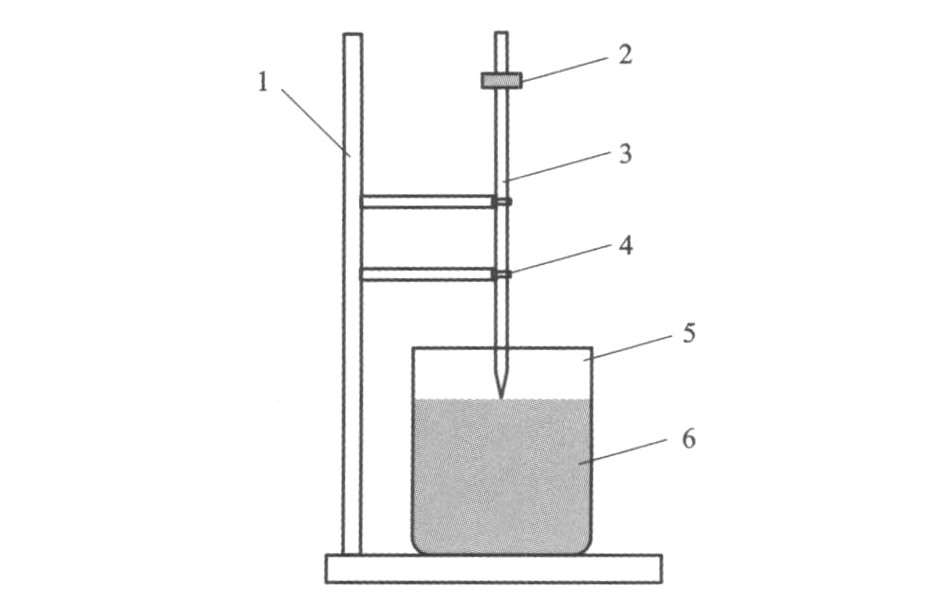Design method of no-fines porous concrete composition based on vibration compaction
-
摘要: 采用浆体贯入度试验方法, 研究了不同水粉质量比的水泥净浆、水泥粉煤灰浆体和水泥硅灰浆体粘稠度变化规律, 分析了混合料拌和过程中浆体与集料的粘附状况以及振动压实下混合料浆体析漏情况, 提出了适合振动压实工况的无砂多孔混凝土组成设计方法。分析结果表明: 在混合料拌和过程中, 随着浆体贯入度的增大, 浆体在集料上的裹覆量先增大后减小, 贯入度在20~40 mm时的裹覆能力较强; 在振动压实条件下, 浆体不出现析漏且试件完整时, 浆体贯入度在20~25 mm之间; 设计的孔隙率为21.8%的无砂水泥混凝土, 试件内部孔隙均匀, 28 d抗压强度能够达到22.8 MPa, 抗折强度达到3.4 MPa。Abstract: The viscosity change rules of cement pastes, cement fly-ash pastes and cement silica fume pastes with different water to powder ratios were studied by using paste penetration test.Paste adhesive capacity to aggregate and paste leakage condition were analyzed based on mixture mixing test and vibration compaction test, and the design method of no-fines porous concrete composition at vibration compaction condition was provided.Analysis result indicates that in the mixing process of mixture, the amount of paste adhered to aggregate increases firstly and then decreases with the increase of paste penetration value, and paste adhesive ability is great when penetration value is 20-40 mm.Penetration value is further narrowed to 20-25 mm to avoid paste leakage and specimen damage at vibration compaction condition.No-fines porous concrete with 21.8% void ratio is designed by using the method, pore distribution in specimens is uniform, and 28 d compressive strength and flexural strength can reach 22.8 MPa and 3.4 MPa respectively.
-
Table 1. Cement performance indexes
Density/(g·cm-3) Setting time/min Flexural strength/MPa Compressive strength/MPa Initial setting time Final setting time 3 d 28 d 3 d 28 d 3.05 165 230 3.8 6.8 21.8 43.4 Table 2. Properties of fly ash
Composition content/% Loss on ignition/% Density/(g·cm-3) Water content/% Specific surface area/(m2·g-1) SiO2 Al2O3 Fe2O3 CaO MgO 52.45 31.28 5.13 2.20 0.39 2.42 1.90 0.80 1.50 Table 3. Properties of silica fume
Composition content/% Loss on ignition/% Density/(g·cm-3) Water content/% Specific surface area/(m2·g-1) SiO2 Al2O3 Fe2O3 CaO MgO 87.38 0.64 0.81 1.12 1.45 1.03 2.20 0.60 21.4 Table 4. Coarse aggregate gradations
Aggregate type Each sieve pore(mm) passing rate/% 13.2 9.5 4.75 2.36 A 100 0 0 B 100 0 0 C 100 84 24 0 Table 5. Proportions of different pastes
Paste type Water to powder ratio by weight Water con-sumption/g Cement con-sumption/g Fly ash con-sumption/g Silica fume consumption/g Cement paste 0.20 60 300 0.25 75 300 0.30 90 300 0.35 105 300 0.40 120 300 Cement fly ash paste 0.20 60 260 40 0.25 75 260 40 0.30 90 260 40 0.35 105 260 40 0.40 120 260 40 Cement silica fume paste 0.20 60 260 40 0.25 75 260 40 0.30 90 260 40 0.35 105 260 40 0.40 120 260 40 Table 6. Grades of molding specimen
Grade Molding phenomenon description Paste stripping situation Paste leakage situation Void status Demoulding status E No stripping No leakage Distribute uniformly, and no clogging Shape well without loosing F Strip slightly Leak slightly Be clogged partly Loose partly G Strip seriously Flow to the bottom of specimen Be clogged seriously Can not be shaped Table 7. Test results of paste
Paste type Cement paste Cement fly ash paste Cement silica fume paste Water to powder ratio/% 0.305 0.315 0.320 Wet density/(g·cm-3) 2.632 2.394 2.414 Flexural strength/MPa 4.5 5.3 6.3 Table 8. Aggregate gradation
Particle size/mm 19 13.2 9.5 4.75 Passing rate/% 100 85 45 0 Table 9. Test results of no-fines porous concrete
Test index 28 d compressive strength/MPa 28 d flexural strength/MPa Void ratio/% Value 22.8 3.4 21.8 -
[1] SUN Dao-sheng, HU Pu-hua, DUAN Jia-chao, et al. Preliminary study of preparation of non-sand big-hole planting concrete[J]. Journal of Anhui Institute of Architecture and Industry, 2004, 12(1): 35-39. https://en.cnki.com.cn/Article_en/CJFDTOTAL-AHJG200401008.htm [2] HUO Liang. Preparation, properties of pervius concrete pavement material[D]. Nanjing: Southeast University, 2004. [3] ZHAO Ya-lan, XING Xiang-yang. Structure and construction technology of low-noise anti-skid cement concrete pavement[J]. Road Machinery and Construction Mechanization, 2009, 26(6): 43-46. https://en.cnki.com.cn/Article_en/CJFDTotal-ZLJX200906024.htm [4] KIM H K, LEE H K. Influence of cement flow and aggregate type on the mechanical and acoustic characteristics of porous concrete[J]. Applied Acoustics, 2010, 71(7): 607-615. doi: 10.1016/j.apacoust.2010.02.001 [5] PENG Liang-tao, YANG Cheng-zhong, MIN Chang-hua, et al. Analysis of measures of reducing noises for cement concrete[J]. Road Machinery and Construction Mechanization, 2007, 24(10): 30-32. [6] PUTMAN B J, NEPTUNE A I. Comparison of test specimen preparation techniques for pervious concrete pavements[J]. Construction and Building Materials, 2011, 25(8): 3480-3485. doi: 10.1016/j.conbuildmat.2011.03.039 [7] CHINDAPRASIRT P, HATANAKA S, MISHIMA N, et al. Effects of binder strength and aggregate size on the compres-sive strength and void ratio of porous concrete[J]. International Journal of Minerals, Metallurgy and Materials, 2009, 16(6): 714-719. https://www.sciencedirect.com/science/article/pii/S1674479910600180 [8] SHENG Yan-ping, CHEN Shuan-fa, ZHENG Mu-lian, et al. Mix design method of porous concrete with non-vibration molding[J]. Journal of Traffic and Transportation Engineering, 2009, 9(1): 44-49. [9] TAO Xin-ming. Non-fines macroporous concrete mixing ratio design, forming and curing[J]. Concrete, 2010(10): 136-138, 141. [10] TIAN Bo, NIU Kai-min, TAN Hua, et al. Research on indoor shaping methods of porous lean cement concrete used as a base material[J]. Highway, 2006(1): 150-154. [11] CHEN Yu, ZHANG Qi-sen, GAO Ying-li. Experiment on mechanical performances of porous cement concrete applied to surface layer of highway pavement[J]. China Journal of Highway and Transport, 2010, 23(2): 18-24. [12] LI Xue-jun, WANG Ming-xiang. Research on no-fines concrete[J]. Water Resources and Water Engineering, 1997, 8(4): 28-31. [13] XU Fei, XIAO Dang-qi. Research on mix proportion of nofines and porous concrete[J]. Journal of Water Resources and Architectural Engineering, 2005, 3(4): 24-26, 38. https://oversea.cnki.net/kcms/detail/detail.aspx?dbcode=CJFD&dbname=CJFD2005&filename=FSJS200504006 [14] LIU Juan-hong, WANG Sheng-yong, WANG Bo, et al. No-fines pervious concrete in the Beijing North-South Long Street road engineering[J]. Concrete, 2006(3): 81-83. https://en.cnki.com.cn/Article_en/CJFDTOTAL-HLTF200603019.htm [15] LI Qing-quan, LI Zhi-gang. Study on performance of modified no-fines concrete[J]. Journal of Highway and Transpor-tation Research and Development, 2009, 26(1): 61-65. [16] LIAN C, ZHUGE Y, BEECHAM S. The relationship between porosity and strength for porous concrete[J]. Construction and Building Materials, 2011, 25(11): 4294-4298. doi: 10.1016/j.conbuildmat.2011.05.005 [17] ZHENG Mu-lian, CHEN Shuan-fa, WANG Chong-tao. Strength character of porous concrete[J]. Journal of Chang'an University: Natura 1 Science Edition, 2006, 26(4): 20-25. [18] ZHANG Xian-chao, YIN Jian, CHI Yi. Summary of performance for pervious concrete[J]. Concrete, 2010(12): 47-50. https://oversea.cnki.net/kcms/detail/detail.aspx?dbcode=CJFD&dbname=CJFD2010&filename=HLTF201012015 -





 下载:
下载:









